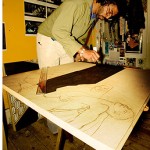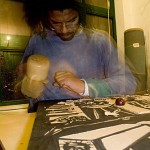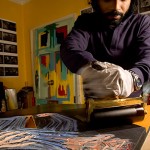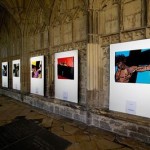Stations of the Cross

– “I am an artist. Artists have answers for which they try to find the right questions.” – Madelon Vriesendorp.
Research forms the major part of my arts practice; informing the appropriate medium to use. The Stations of the Cross began as a journey of bridge building between an understanding of my Buddhist faith and Christian upbringing, to a universal message of human struggle and hope. The Stations of the Cross was exhibited at Gloucester Cathedral Cloisters for Lent 2006, and re-exhibited for Lent 2007
Reactions
“An Easter Reflection – What sort of picture do you have in your mind when someone speaks about the Resurrection? One of the most difficult tasks that any artist has is to depict the Resurrection of Jesus Christ. Perhaps the most effective paintings are those of two incidents recorded in the gospels – the moment when Mary Magdalene speaks to the gardener and then realises it is her Lord, and the story of the road to Emmaus. Both of these concern people realising what had happened and how this fact would change their lives. Both stories have ordinary people in despair at the beginning of the story and then full of joy at the end.
One of the most moving pictures from Romanesque art is a carving on a capital in Pamplona Cathedral carved in the 12th century. Here we see Mary Magdalene trying hard to convince the incredulous disciples that she has seen the risen Christ. Some do not look at all impressed. It seems to me a very modern scene. The realisation that there is a living God who loves each one of us and in whom we can put all our trust, is surely a defining moment for any follower of Christ. It should give every Christian a huge boost every time he or she thinks of it. And most should, like Mary Magdalene, want to share the news to others.
I was therefore intrigued when I learned that Graeme Evelyn the artist who has made the Stations of the Cross, which are in the West Walk of the Cloisters, said he was going to make a “fifteenth station” – that is, traditionally, a depiction of the Resurrection.
The reason I was so intrigued is that Graeme is a Buddhist.
What has he done? He has a picture of an adult holding the hand of a child and pointing to the stars and they are standing on the shadow of the cross.
I am not sure exactly what Graeme intends with this work but, of course, speaking with children about the death of someone whom they have loved greatly is always difficult and some have, in a rather sentimental way, suggested that such a person is now a star in the heavens.
The more conventional Christian thing to say might be that the love that person had for the child is something that carries on past death and certainly that the love that God has for us can, in the words of St Paul, never be broken. The Resurrection has broken the power of death.
But the thing that really surprised me about Graeme’s picture is that this parent and child are standing in the shadow of the cross. That is precisely right. It is the cross that breaks the power of death. The very fact that Christ willingly suffers for the people whom he loves shows that his is an unconditional sacrificial love. It is that fact which makes the cross so powerful and, for me, makes Graeme’s work such a powerful one.
I would love to hear what readers of this newsletter think of Graeme’s work. I think these Stations of the Cross are some of the most powerful I have seen, but it would be good to hear how they have struck others.”
Nick Bury – Dean of Gloucester Cathedral.
Excerpt taken from Gloucester Cathedral Newsletter April 2006 www.gloucestercathedral.org.uk
Currently, the Stations of the Cross is on loan to the Diocese of London to accompany The Eternal Engine altarpiece in St Francis Church Sanctuary Hall, as well as the loan for the St Francis Chapel – the principal study artwork for the altarpiece commission, Voyager – Pillars of Creation. This now represents an historic cultural achievement that a contemporary artist has been afforded a singular vision for all the artwork in a modern church setting and for the only Anglican Church built in London for over 50 years. It is believed that this has not been established by an artist since Matisse’s Chapelle du Rosaire de Vence, Chagall’s stained glass for All Saints Church in Tudeley or Rothko’s Chapel. Photography: @tatianagorilovsky (2020)


 Graeme Mortimer Evelyn
Graeme Mortimer Evelyn



























